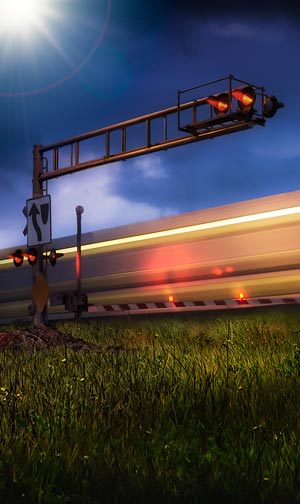NTSB Finds UP Crew Missed Three Signals Before Triple Fatality Collision in Oklahoma Panhandle
(Tulsa, Oklahoma – February 26, 2013)
Although no reason was provided, the National Transportation Board in releasing the results of the body’s investigation into a head-on collision between two Union Pacific freight trains that killed three crew members and seriously injured a fourth near the Oklahoma Panhandle town of Goodwell on June 24, 2012 found that the eastbound train passed three signals that should have told the engineer to first slow it down and eventually stop his train prior to a collision with a westbound train that had slowed nearly to a stop itself.
Evidentially someone on the eastbound freight realized the danger and applied the train’s emergency braking system eight seconds before that train, travelling at 68 mph, struck the westbound train. Of the crew members on the two trains, only the conductor of the westbound survived when he jumped prior to the deadly crash.
Union Pacific Vice President of Safety Robert Grimaila testified that UPRR employees can be suspended or face other consequences for ignoring or missing a signal. “We never want to see another accident like this happen again,” Grimaila told the NTSB panel.
The NTSB, in its “Wish List” for railroad safety improvement in 2013 had listed the installation and activation of a satellite-based “Positive Train Control” system which will override crew failure to stop a train under the circumstances such as occurred June 24, and which was originally legislated to become national train operation reality in 2015, but which now has been pushed back another five years.
Union Pacific official Jeff Young told the NTSB panel that UPRR had already invested more than one billion dollars to implement the PTC system, but estimated it would still be 2017 or 2018 before UP could activate their portion of the system. “People don’t appreciate the complexity of what we’re doing here,” Young told the NTSB. “This is a huge paradigm shift. The last thing we want to do is be back here with a collision that occurred because we weren’t vigilant in testing and operating this whole new control system,” Young continued. “This system hasn’t even been field tested yet,” he concluded.
Robert Lauby of the Federal Railroad Administration said that while the number of signal violations on railroads nationwide had declined, there are still too many. “We need different techniques to take it down to the next level, to make railroads even safer.”
But Brotherhood of Locomotive Engineers and Trainmen official Dennis Pierce cast a dim light upon current railroad operations, explaining that railroad engineers suffer from “task overload” and must navigate new technology and reams of bulletins and memos as well as watching where their train is travelling. “It’s obvious to most of us there are limitations on how many tasks a human being can safely accomplish, and engineers must multitask more than ever before…under intense scrutiny.”
Thus far, it is estimated that the tragic collision resulted in $15 million in damage.


